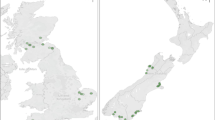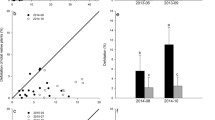Abstract
The Enemy Release hypothesis holds that exotic plants may have an advantage over native plants because their specialized natural enemies are absent. We tested this hypothesis by measuring leaf damage and plant abundance for naturally-occurring plants in prairies, and by removing natural enemies in an enemy exclusion experiment. We classified plants as invasive exotic, noninvasive exotic, or native, to determine if their degree of invasiveness influenced their relationships with natural enemies. Our field surveys showed that invasive exotic plants generally had significantly lower levels of foliar damage than native species while there was no consistent pattern for noninvasive exotics compared to natives. The relationship between damage and abundance was different for exotic and native plants: foliar damage decreased with increasing abundance for exotic plants while the trend was positive for native plants. While these results from the field surveys supported the Enemy Release Hypothesis, the enemy exclusion experiment did not. There was no relationship between a species’ status as exotic or native and its degree of release from herbivory. Pastinaca sativa, the invasive exotic in this experiment, experienced gains in leaf area and vegetative biomass when treated with pesticides, indicating substantial herbivore pressure in the introduced range. These results show that foliar damage may not accurately predict the amount of herbivore pressure that plants actually experience, and that the Enemy Release hypothesis is not sufficient to explain the invasiveness of P. sativa in prairies.



Similar content being viewed by others
References
Agrawal AA, Kotanen PM (2003) Herbivores and the success of exotic plants: a phylogenetically controlled experiment. Ecol Lett 6:712–715
Agrawal AA, Kotanen PM, Mitchell CE, Power AG, Godsoe W, Klironomos J (2005) Enemy release? An experiment with congeneric plant pairs and diverse above- and belowground enemies. Ecology 86:2979–2989
Baskin JM, Baskin CM (1979) Studies on the autoecology and population biology of the weedy monocarpic perennial, Pastinaca sativa. J Ecol 67:601–610
Beckstead J, Parker IM (2003) Invasiveness of Ammophila arenaria: release from soil-borne pathogens? Ecology 84:824–2831
Berenbaum M (1981) Patterns of furanocoumarin distribution and insect herbivory in the Umbelliferae: plant chemistry and community structure. Ecology 62:1254–1266
Berenbaum MR, Zangerl AR (2006) Parsnip webworms and host plants at home and abroad: trophic complexity in a geographic mosaic. Ecology 87:3070–3081
Blaney CS, Kotanen PM (2001a) Effects of fungal pathogens on seeds of native and exotic plants: a test using congeneric pairs. J Appl Ecol 38:1104–1113
Blaney CS, Kotanen PM (2001b) Post-dispersal losses to seed predators: an experimental comparison of native and exotic old field plants. Can J Bot 79:284–292
Callaway RM, Thelan GC, Rodriguez A, Holben WE (2004) Soil biota and exotic plant invasion. Nature 427:731–733
Cappuccino N, Carpenter D (2005) Invasive exotic plants suffer less herbivory than non-invasive exotic plants. Biol Lett 1:435–438
Carpenter D, Cappuccino N (2005) Herbivory, time since introduction and the invasiveness of exotic plants. J Ecol 93:315–321
Cochrane TS, Iltis HH (2000) Atlas of the Wisconsin prairie and savanna flora. Technical Bulletin No. 191. University of Wisconsin-Madison, Madison
Colautti RI, Ricciardi A, Grigorovich IA, MacIsaac HJ (2004) Is invasion success explained by the enemy release hypothesis? Ecol Lett 7:721–733
DeWalt SJ, Denslow JS, Ickes K (2004) Natural-enemy release facilitates habitat expansion of the invasive tropical shrub Clidemia hirta. Ecology 85:471–483
Diaz FJ, McLeod P (2005) Movement, toxicity, and persistence of imidacloprid in seedling tabasco pepper infested with Myzus persicae (Hemiptera: Aphididae). J Econ Entomol 98:2095–2099
Dietz H, Wirth LR, Buschmann H (2004) Variation in herbivore damage to invasive and native woody plant species in open forest vegetation on Mahé, Seychelles. Biol Invasions 6:511–521
Elton CS (1958) The ecology of invasions by animals and plants. Methuen, London
Genton BJ, Kotanen PM, Cheptou P, Adolphe C, Shykoff JA (2005) Enemy release but no evolutionary loss of defence in a plant invasion: an inter-continental reciprocal transplant experiment. Oecologia 146:404–414
Gross KL (1981) Predictions of fate from rosette size in four ‘‘biennial’’ plant species: Verbascum thapsus, Oenothera biennis, Daucus carota, Tragopogon dubius. Oecologia 48:209–213
Gross KL, Werner PA (1982) Colonizing abilities of ‘‘biennial’’ plant species in relation to ground cover: implications for their distribution in a successional sere. Ecology 63:921–931
Hill SB, Kotanen PM (2009) Evidence that phylogenetically novel non-indigenous plants experience less herbivory. Oecologia 161:581–590
Holt BR (1972) Effect of arrival time on recruitment, mortality, and reproduction in successional plant populations. Ecology 53:668–673
Jakobs GE, Weber E, Edwards PJ (2004) Introduced plants of the invasive Solidago gigantea (Asteraceae) are larger and grow denser than conspecifics in the native range. Divers Distrib 10:11–19
Keane RM, Crawley MJ (2002) Exotic plant invasions and the enemy release hypothesis. Trends Ecol Evol 17:164–170
Knight TM (2007) Population-level consequences of herbivory timing in Trillium grandiflorum. Am Midl Nat 157:27–38
Liu H, Stiling P (2006) Testing the enemy release hypothesis: a review and meta-analysis. Biol Invasions 8:1535–1545
Lockwood JL, Simberloff D, McKinney ML, Von Holle B (2001) How many, and which, plants will invade natural areas? Biol Invasions 3:1–8
Lohman DJ, Zangerl AR, Berenbaum MR (1996) Impact of floral herbivory by parsnip webworm (Oecophoridae: Depressaria pastinacella Duponchel) on pollination and fitness of wild parsnip (Apiaceae: Pastinaca sativa L.). Am Midl Nat 136:407–412
Maron JL, Crone E (2006) Herbivory: effects on plant abundance, distribution and population growth. Proc Royal Soc B 273:2575–2584
Maron JL, Vilà M (2001) When do herbivores affect plant invasion? Evidence for the natural enemies and biotic resistance hypothesis. Oikos 95:361–373
Maschinski J, Whitham TG (1989) The continuum of plant responses to herbivory: the influence of plant association, nutrient availability, and timing. Am Nat 134:1–19
Meyer GA (1993) A comparison of the impacts of leaf and sap-feeding insects on growth and allocation of goldenrod. Ecology 74:1101–1116
Meyer GA, Root RB (1993) Effects of herbivorous insects and soil fertility on reproduction of goldenrod. Ecology 74:1117–1128
Mitchell CE (2003) Trophic control of grassland production and biomass by pathogens. Ecol Lett 6:147–155
Mitchell CE, Power AG (2003) Release of invasive plants from fungal and viral pathogens. Nature 421:625–627
Mitchell CE, Agrawal AA, Bever JD, Gilbert GS, Hufbauer RA, Klironomos JN, Maron JL, Morris WF, Parker IM, Power AG, Seabloom EW, Torchin ME, Vazquez DP (2006) Biotic interactions and plant invasions. Ecol Lett 9:726–740
Morandin LA, Winston ML (2003) Effects of novel pesticides on bumble bee (Hymenoptera: Apidae) colony health and foraging ability. Environ Entomol 32:555–563
Parker IM, Gilbert GS (2007) When there is no escape: the effects of natural enemies on native, invasive, and noninvasive plants. Ecology 88:1210–1224
Prieur-Richard AH, Lavorel S, Linhart YB, Dos Santos A (2002) Plant diversity, herbivory and resistance of a plant community to invasion in mediterranean annual communities. Oecologia 130:96–104
Reinhart KO, Packer A, Van der Putten WH, Clay K (2003) Plant–soil biota interactions and spatial distribution of black cherry in its native and invasive ranges. Ecol Lett 6:1046–1050
Root RB (1973) Organization of a plant-arthropod association in simple and diverse habitats: the fauna of collards (Brassica oleracea). Ecol Monogr 43:95–124
Schierenbeck KA, Mack RN, Sharitz RR (1994) Effects of herbivory on growth and biomass allocation in native and introduced species of Lonicera. Ecology 75:1661–1672
Siemann E, Rogers WE (2003) Herbivory, disease, recruitment limitation, and success of alien and native tree species. Ecology 84:1489–1505
Trappe JM, Molina R, Castellano M (1984) Reactions of mycorrhizal fungi and mycorrhiza formation to pesticides. Annu Rev Phytopathol 22:331–359
Vasquez EC (2008) The effects of enemy exclusion and enemy damage on exotic and native plant species: a test of the enemy release hypothesis. MS Thesis, University of Wisconsin-Milwaukee, Milwaukee
Verhoeven KJF, Biere A, Harvey JA, van der Putten WH (2008) Plant invaders and their novel natural enemies: who is naive? Ecol Lett 12:107–117
Wisconsin State Herbarium (2005) Wisflora: Checklist of the vascular plants of Wisconsin. University of Wisconsin-Madison Herbarium web site. http://www.botany.wisc.edu/wisflora/
Wolfe LM (2002) Why alien invaders succeed: support for the escape-from-enemy hypothesis. Am Nat 160:705–711
Zangerl AR, Berenbaum MR (2005) Increase in toxicity of an invasive weed after reassociation with its coevolved herbivore. PNAS 43:15529–15532
Acknowledgments
We thank Jim Reinartz and Stefan Schnitzer for advice and helpful comments and Kayvon Ali for assistance in the field and laboratory. The Wisconsin Department of Natural Resources granted permission to use many of the sites for this experiment, and in particular we are grateful to Matt Zine for his assistance at Young Prairie. Mike Fort assisted with plant identification. Two anonymous reviewers provided comments that improved the manuscript. This research was supported by a Ruth Walker Grant-in-Aid and an Advanced Opportunity Fellowship, both from the University of Wisconsin-Milwaukee, to ECV.
Author information
Authors and Affiliations
Corresponding author
Rights and permissions
About this article
Cite this article
Vasquez, E.C., Meyer, G.A. Relationships among leaf damage, natural enemy release, and abundance in exotic and native prairie plants. Biol Invasions 13, 621–633 (2011). https://doi.org/10.1007/s10530-010-9853-1
Received:
Accepted:
Published:
Issue Date:
DOI: https://doi.org/10.1007/s10530-010-9853-1




